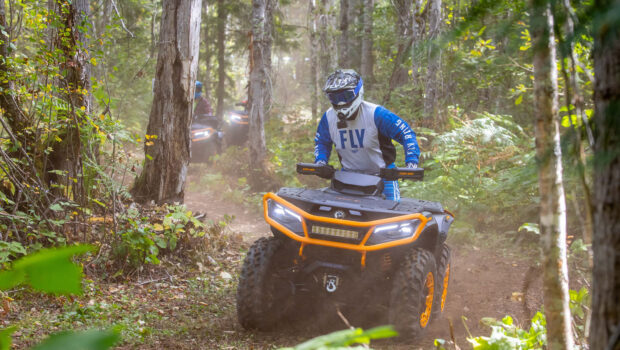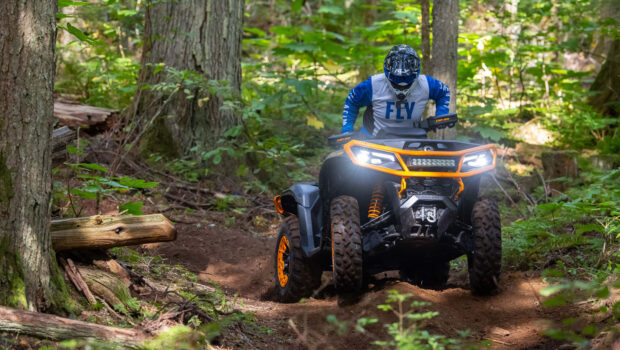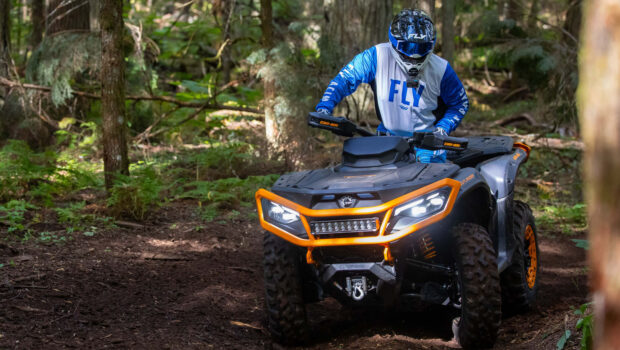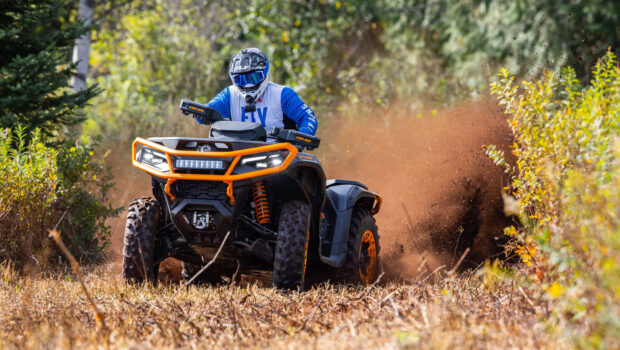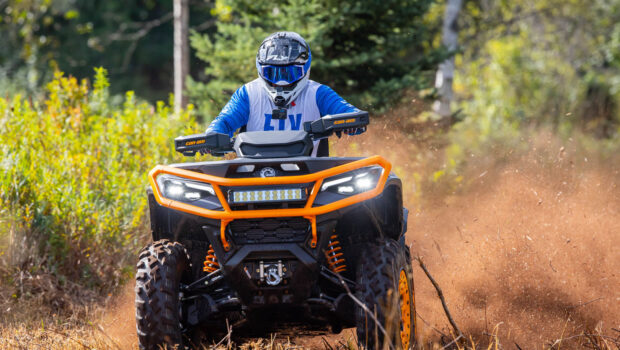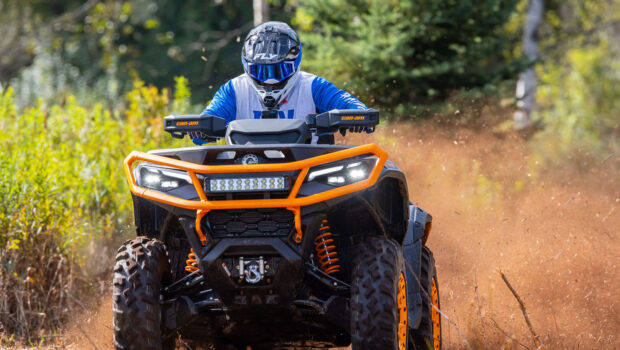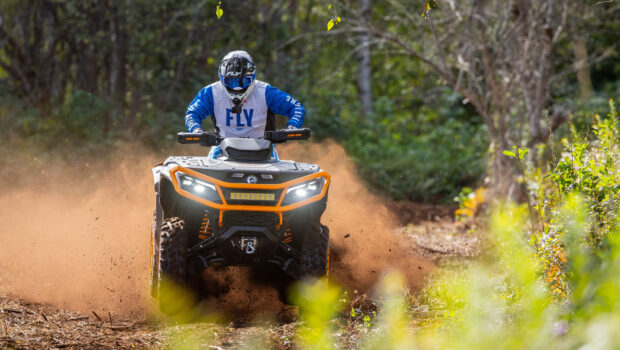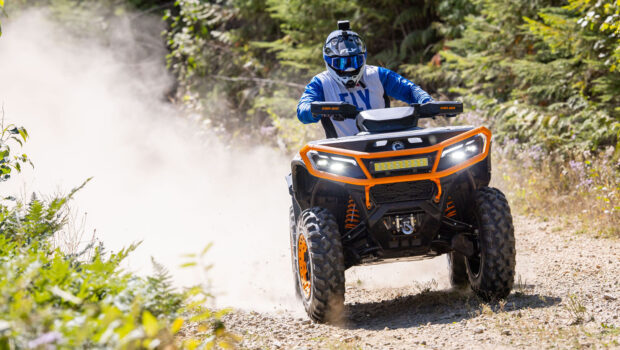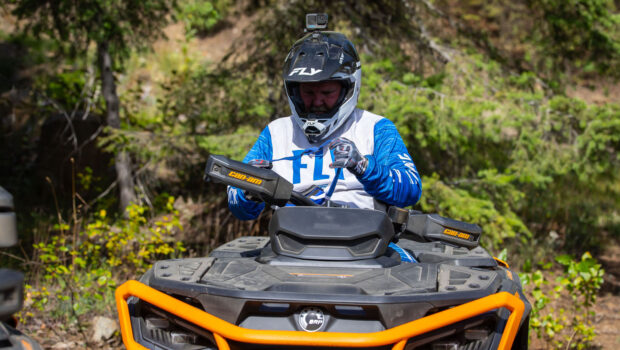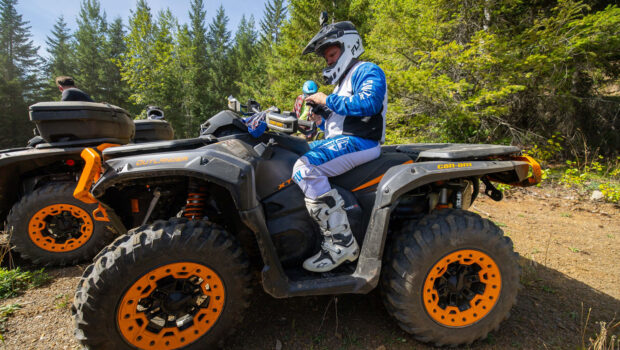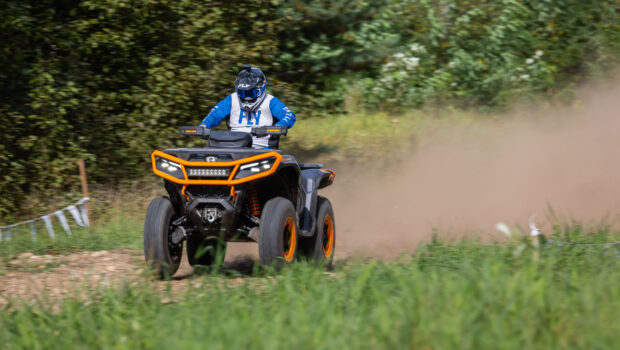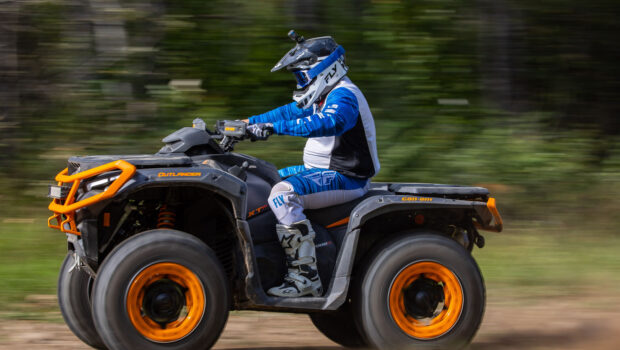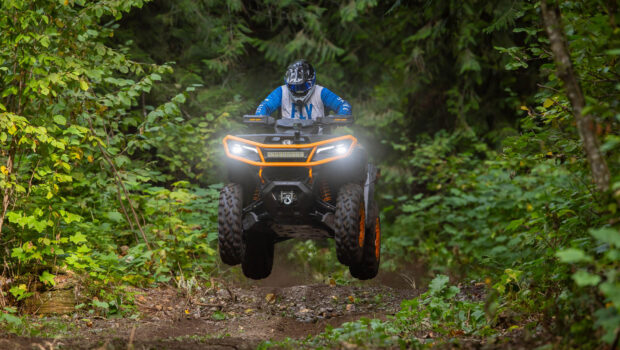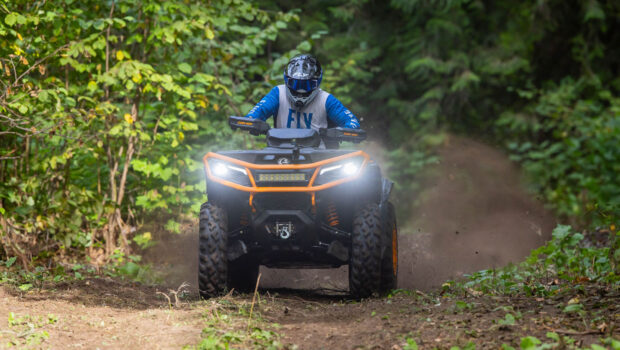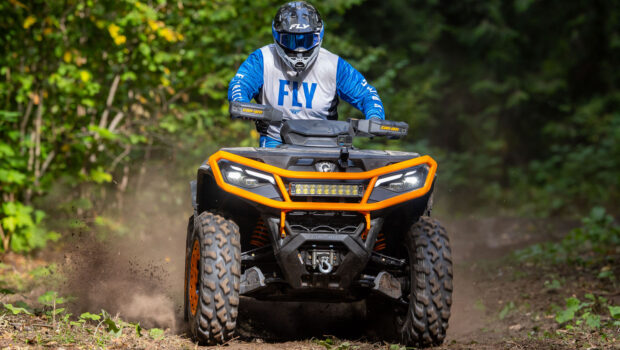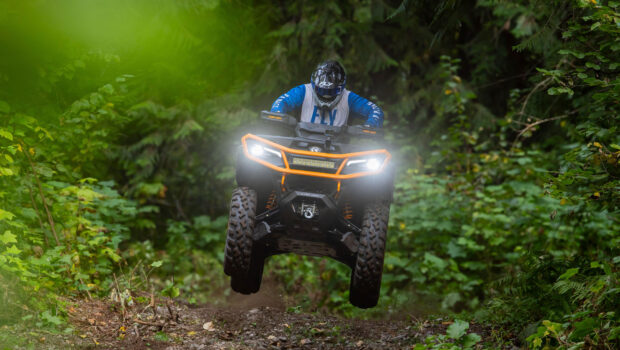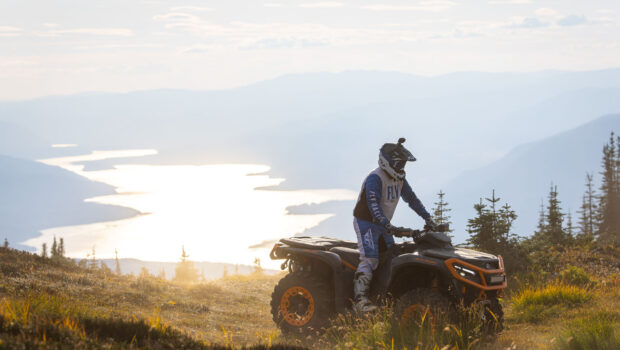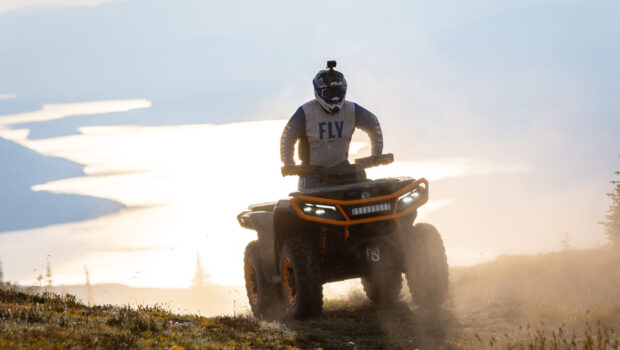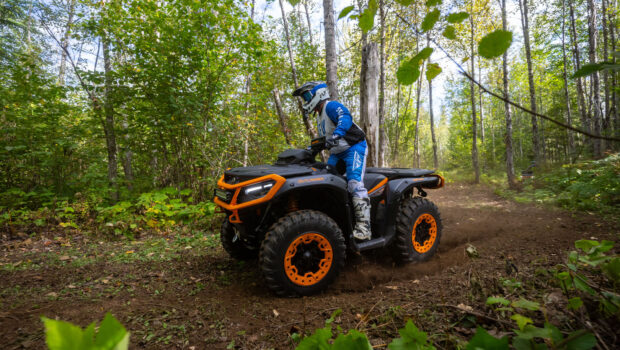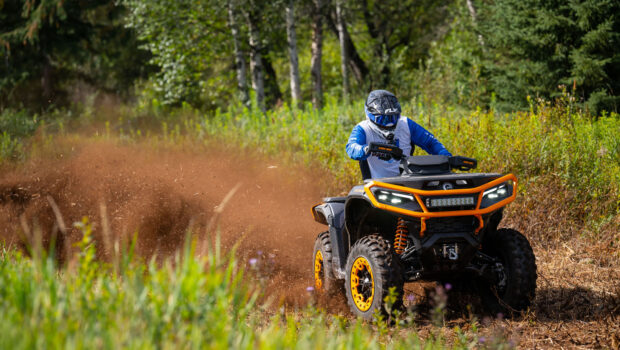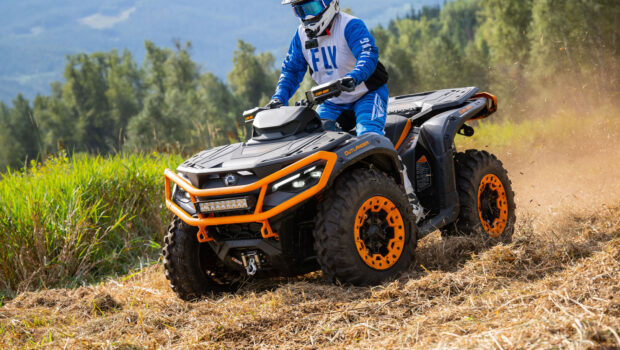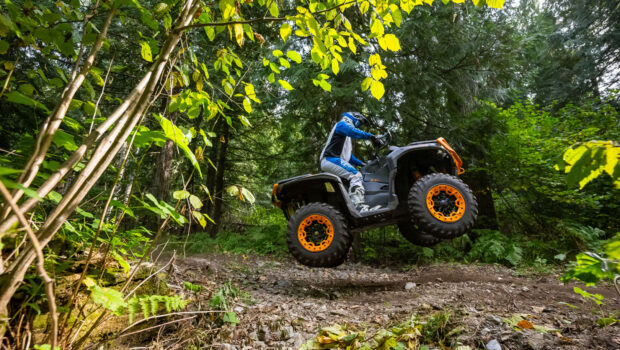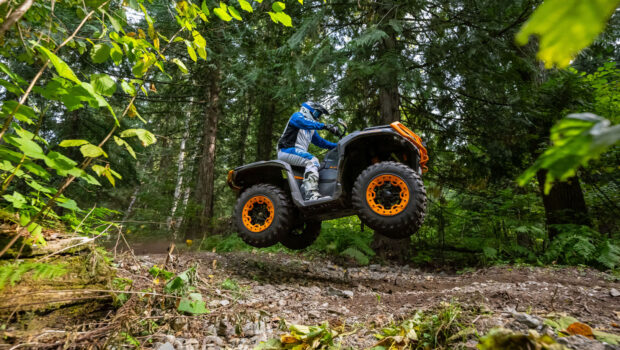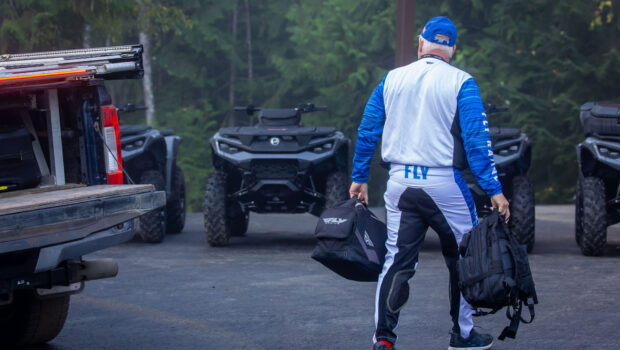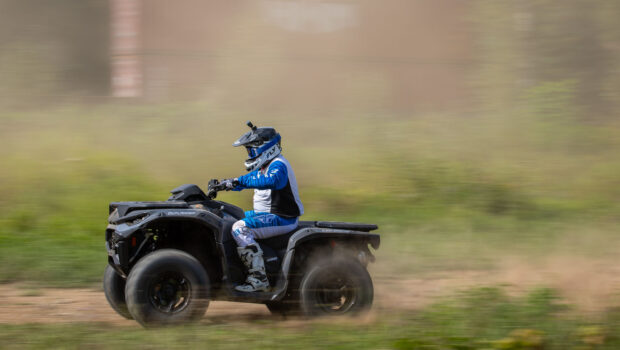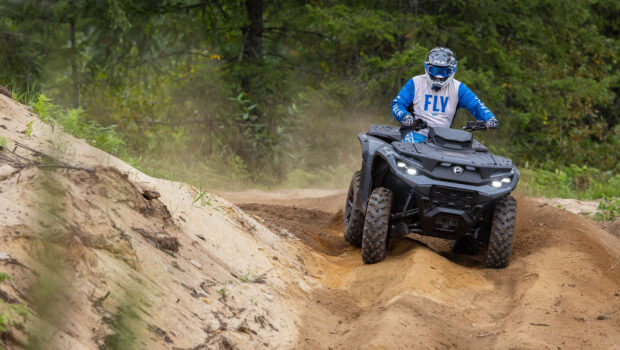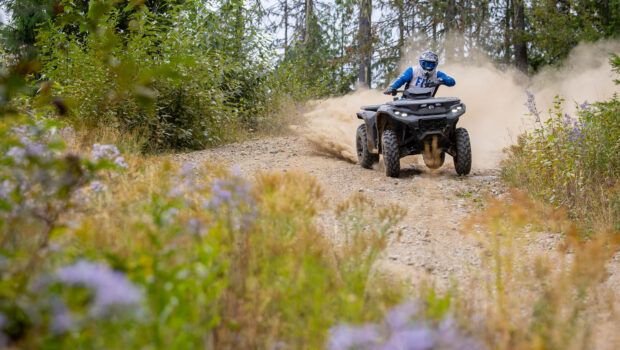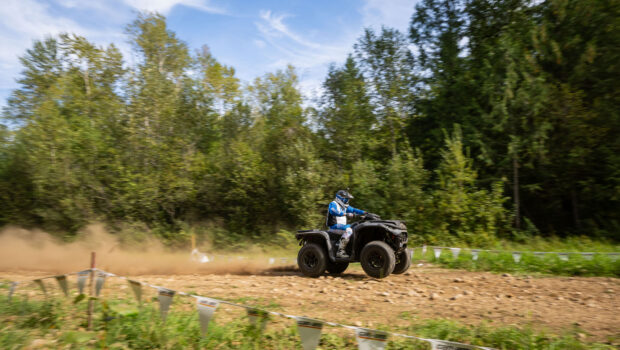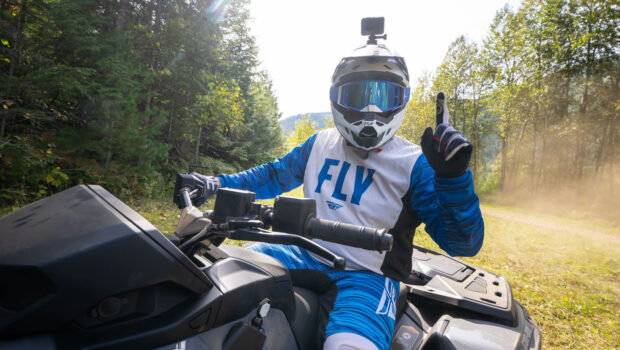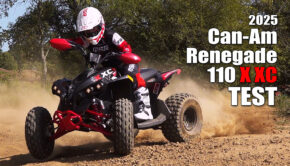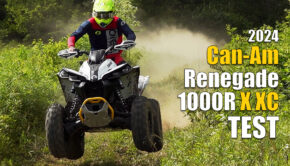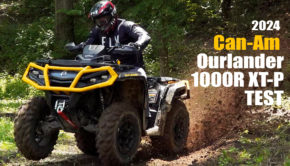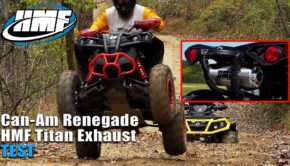Published on October 6th, 2024 | by Joe
2025 Can-Am Outlander 1000R XT-P and 850 DPS Test Review
2025 Cam-Am Outlander 1000R XT-P Ratings
Summary: The Gen-2 Outlander 1000R XT-P set the standard in big-bore ATV performance in our 2020 1000cc ATV Shootout. Based on our first rides, the new Gen-3 Outlander 850 and 1000R set the new standard in big-bore ATV performance!
4.5
1 Day Test
The Best Twin Cylinder Big-Bore ATVs Get Even Better!
In recent history, it’s been difficult to dispute Can-Am as the performance leader in the big-bore 4X4 ATV segment as proven by numerous GNCC championships in addition to our 2020 1000cc 4×4 ATV Shootout, where the 91HP Outlander 1000R XT-P took the win over the 90 HP Polaris Sportsman XP 1000. Since then, the horsepower war has reignited with a 90 HP 2-UP model from CFMoto and the Segway AT10 producing a claimed 96 HP!
Determined to remain at the top of the big-bore 4×4 ATV segment, Can-Am has released an all-new, big-bore sport utility lineup for 2025. Boasting more than increased horsepower, the new Outlander 850 and 1000 models are 95% brand new from the ground up. In our test of the new Outlander 500 and 700 last year, we stated that their new chassis appeared capable of dealing with far more horsepower. It left us feeling that the new 500/700 chassis was destined to become the platform for an updated Outlander 850 and 1000 as it offered improved handling and suspension characteristics over its bigger siblings. As it turned out, we were right.
To show off their new 2025 big-bore models, Can-Am invited us to the Carl Kuster Mountain Park in Malakwa, BC, Canada for two days of testing on the Outlander 1000R XT P and 850 DPS. We sent vet ATV Racer and ATV Talk host, Leonard Duncan, to evaluate the machines for us based on his years of racing and mechanical experience.
Trim Packages
Can-Am offers 6 single-seat trim packages, including the X MR models, in addition to numerous two-up models. To keep things a little simpler ,we’re only covering the single-seat trim packages.
Trim packages begin with the standard, non-power steering equipped model. It still boasts premium features like 3-mode intelligent throttle and Intelligent Engine Braking, LED lighting, full chassis skid plate, phone storage, a Digitally Encoded Security System Key, and a square tire setup. Steel wheels are used to keep prices in check, and the base model is available as an 850 only for $11,199.
Available in 850 or 1000R engine options, the DPS model gains Tri-mode Dynamic Power Steering, faster locking Visco-Lok, QE front differential, and aluminum wheels. The 1000R switches from 12 to 14” alloy wheels, adds dual rear disc brakes, and LED signature front accent lights. Pricing for the 850 is $12,499 with the 1000R at $13,899 .
The XT package picks up a 3,500 lb winch, front and rear steel bumpers, full wrap handguards, phone holder with USB charger, plus a camo color option. Tire size remains the same at 26”, but the tires are upgraded to Can-Am’s in-house XPS brand, Trail King 2 tires mounted on 14” aluminum wheels on both the 850 and 1000R. The XT 1000R also picks up a Visco-4Lok lockable front differential, a front sway bar, dual rear brakes, and signature LED front accent lights. The XT 850 starts at $13,649 with the 1000R at $15,049.
The more sport focused XT-P package is available as a 1000R only, building on the XT 1000R package; coloring is unique throughout. Shocks are upgraded to piggyback, Fox Podium 1.5 QS3. Tire size increased 1” with 27” XPS Trail King 2 tires mounted 14” aluminum beadlock wheels with a square setup like the others. A handlebar riser topped with aluminum tapered handlebars with wrap-around sport handguards and a special edition seat cover round out the upgrades. Retail pricing starts at a whopping $16,599.
Totally decked out for mud riding with snorkels and a relocated radiator, Can-Am legendary X MR mud machines are also brand new for 2025. The 850 retails for $14,999 with the 1000 going for $16,599. We hope to have a full test with complete details in a coming video.
Ergonomics and Styling
The new Outlanders retain a distinctively Can-Am look with a slightly more angular, aggressive, and lower profile appearance. Let us know what you think of it. Dual LED head and tail lights are modern and plenty bright for night riding at a good pace.
Stepping aboard the machines, the ergonomics have been greatly improved. Gone are the bulges on the sides of the CVT. The width between your feet is unchanged according to Can-Am, but it feels as though it’s been narrowed up thanks to the new side body panels that allow you to more easily grip the quad with your legs. The floorboards are spacious and the plastic foot pegs are tall and wide enough with kick-ups on the ends for added control. However, Can-Am’s accessory aluminum pegs would have been nice on the XT-P, due to its sportier intentions. The new seat remains comfortable and welcoming although we preferred the feel of the higher end cover on the XT-P.
With switches everywhere to control the different modes, the cockpit seems a bit busy until you get used to it. The layout is pretty intuitive. Mounted on riders, the straighter aluminum handlebars on the 1000R XT-P were well shaped for aggressive riding. The more swept back bars of the 850 are better suited for casual cruising. However, we’d prefer a straighter sweep bar similar to the XT-P, regardless of material. Can-Am continues to mount their 7.6” digital display in front of the handlebars, allowing you to switch to any type of handlebar style or bend you prefer. This is the way it should be done on all ride-on ATVs!
Engine Performance
Like the 500 and 700, which share a 650cc engine with different horsepower and torque numbers through different tuning, the new 850 and 1000R share a brand new 999cc, Gen-3, Rotax, V-twin engine. The 1000R puts out a claimed, nutty 101 hp and 69 lb-ft of torque, a 10 HP increase. The 850 pumps out 82 hp, a 4HP increase, and 66 lb-ft of torque, only 3 ft-lbs less than the new 1000R. The only difference between the engines is clutching, ECU tuning, and more airflow over the radiator on the 1000R. We think it makes more sense to market both machines as a 1000 with different tuning and horsepower outputs like automotive companies, but what do we know? Maybe a 1000 and a 1000R? The 1000R now enjoys an 11 hp lead over its closest single-seat rival, the 90 hp Sportsman 1000.
The new V-twin features four valves and DOHCs per cylinder. Compression ratio on the new engine has increased from 10.6:1 on the G2 to near race quad levels at 11.8:1 on the Gen 3. 87 where octane fuel is minimum with 91+ recommended for optimal performance.
A new intake is designed to increase air flow drawn from high in front of the rider where air is cleanest and coolest. Toolless access to the air filter, coolant, and fuse box are located under the front console. Air and fuel are fed to the engine via fuel injection with gas drawn from a 5.1 gal. gas tank. A new exhaust with a center mounted silencer was designed for improved power while retaining the Can-Am v-twin rumble we love.
We were thrilled with the addition of Can-Am’s PDrive roller equipped clutch on the Outlander 500 and 700, and Can-Am now equips it on the Gen-3 850 and 1000R. It reduces friction, maintenance, and harshness under acceleration while offering faster shifting for improved responsiveness thanks to a dual roller driven design vs a friction driven design.
The new, fully automatic CVT continues to offer high and low ranges plus neutral, reverse, and park selected by a gated shifter. Can-Am worked to make gear selection smoother and easier than before. CVT ratios were lowered on takeoff in search of better engagement at lower speeds and improved belt life. The new CVT intake is designed to increase air flow, drawing air from high in front of the rider like the engine for the coolest, cleanest air possible.
Front and rear differentials are new, with spiral bevel cut gears to reduce vibration and noise. Visco-4Lok, lockable front differentials are now found on all XT and up trim packages on the 1000R, plus the 850 and 1000R X MR mud models selected by a toggle switch on the throttle. All of the new, big-bore Outlanders feature Intelligent throttle control offering work, normal, and sport modes to reduce or enhance throttle responsiveness for different uses and conditions. Intelligent Engine Braking is also standard, letting you choose 3 levels of engine braking assistance.
Sadly, the beautiful V-twin Rotax engine has been hidden from site by new full side panels. They are easily removable for maintenance of the engine oil and CVT. Can-Am added them along with heat shields in key areas to help mitigate heat transfer to the rider and key mechanical components. The new engine package, mounts, and all were designed to minimize vibration.
Can-Am is claiming a 0-60 time of 6.6 seconds for the 1000R vs 8.2 seconds for the Sportsman 1000. 7.1 seconds for the Outlander 850 vs 8.9 seconds for the Sportsman 850. So, technically, the Outlander 850, or lower horsepower 1000, is claimed to be quicker accelerating than Polaris’ 1000.
The new PDrive clutch equipped transmissions are outstanding. Gone is the grabby, belt lash from the CVT. Acceleration from a stop or getting back in the throttle is now a butter smooth experience. This makes the power easier to deal with in technical situations or simply in the garage. The lower CVT ratios improve low speed performance. CVT lag is not an issue! Backshifting and CVT responsiveness were instantaneous. Choosing the transmission setting with the gated shifter is also notably smoother than in years past.
Power on the 1000R is electric, starting off incredibly strong, building seamlessly up to the 80MPH we managed to reach. Acceleration feels a bit faster, but the new chassis is better suited to dealing with it, plus the ATV did get a bit heavier.
The throttle’s work mode is best suited for work or less experienced riders who want to take it for a spin, filtering out unwanted stabs of the throttle. . Again, the smoother CVT helps here. Normal mode was great for all-around riding, still filtering out some unwanted throttle input from bumps while still offering full throttle at full throttle. Test rider, Leonard Duncan, left it Sport mode a majority of the time, making the most of the engine’s ludicrous power output.
The 850 was no slouch either. Giving up little torque, low-end power isn’t far off from the 1000R. Midrange and top-end power feel a bit tamer after riding 1000R, but had we ridden it on day-1, it would have certainly been very impressive. In reality, it delivers more power than nearly any rider can fully utilize. The throttle’s normal mode will serve most riders well, but sport mode makes the milder tuned 1000 feel more like the monster that it is.
2wd is fun for sliding. Add in Visco-Lok four-wheel drive, and the machine rails corners with enhanced steering precision. It also enhances stability and steering feel on high-speed straightaways. The Visco-Lok QE system never left us feeling the need to lock the front differential, but it’s a welcomed asset in the toolbox on the 1000R XT and XT-P.
On steep descents, Leonard preferred the Intelligent engine braking’s max assist, allowing the machine to crawl down with less demand on the brakes. For high-speed trail riding, he preferred the minimum assist setting, allowing him to carry more momentum through bumps and into corners.
Overall, both power plants are well refined and very impressive.
Suspension and Handling
The new Outlander is built on a brand new Gen-3 frame. The geometry and materials are new with the steel alloy chassis said to offer enhanced durability and rigidity while reducing weight by 35%. It’s protected by a full-length, 5.5mm thick plastic skid plate, which we applaud, but it’s riveted on, which will make cleaning under it a real pain.
Steering geometry has been revised along with power steering assist in search of improved steering precision and high-speed stability. A front sway bar is found on the XT 1000R and XT-P models for added stability.
The most notable changes are found out back. Gone are the torsional trailing arms, replaced by a sway bar equipped dual A-Arm design. The A-Arm rear end grows in width by 1.5” as the rear suspension compresses under acceleration adding a bit more stability in corners. Can-Am tuned the rear suspension to increase negative camber, or how much the tires lean in under compression, keeping the rear tire rolling flat on the ground, maximizing traction and reducing the tendency of the tire’s outside edge to hook an edge in turns. Rubber bushings were used throughout the suspension components and sway bars to reduce noise and maintenance. Arched A-Arms are used at both ends to maximize clearance.
Suspension travel is now class leading increased by 1.6” front to 10.8”. Rear suspension travel increased by 2.1” to a full 12”. Basic gas charged shocks with five-way spring preload adjustability are used on most models. The XT-P gains piggyback reservoir equipped, Fox 1.5 QS3 shocks featuring threaded preload and 3-way compression adjustability allowing for finer tuning.
Rolling on 26” tires on all trail models except the XT-P, which features Can-Am’s 27” XPS Trail King 2s, ground clearance increased by ½” on most models to 11.5” with the XT-P flying a bit higher with a full foot of ground clearance. Width at standard ride height has increased from 48” to 48.5”. Wheelbase increased from 51” to 52.8” with improved approach and departure angles. Comparing XT-P 1000R’s, seat height increased from 34.5” to 37.8”. The addition of a heavier dual-A-Arm rear suspension and other changes added up to a significant increase in estimated dry weight from 895 lb. to 975 lb.
Both Outlanders delivered enhanced handling and suspension performance. With minimal time to tune suspension, we were able to balance and enhance the XT-P’s handling by switching the QS3 front shocks to their firmest low-speed compression setting with the rears set to their softest settings. This made the most of the front end’s flat cornering manners while keeping the front shocks riding higher in the travel where they’re plushest. Softening the rear shocks let them make full use of their travel on big g-outs without bottoming harshly. The rear-end’s tendency to kick up exiting g-outs seems to have been greatly reduced on the new machines, especially with the XT-P’s shocks.
Our minimal shock changes, combined with the XT-P’s 27” tires left the machine with a firm, sporty, yet forgiving, ride over small bumps. Mid-sized hits were dealt with well. The ride was pretty plush with plenty in reserve for bigger hits. On bigger hits from the creek jump, neither end ever bottomed. Leonard did manage to bottom the rear shocks on a couple abrupt g-outs, again, never seeming to bottom as harshly or kick as abruptly as the previous models. The machine also seemed more composed through rolling bumps.
Improved in 2023, Can-Am had delivered their best power steering yet with the new 2025 models. The DPS low-assist setting was the setting of choice for high-speed terrain. It makes the front end feel less twitchy, delivering positive feedback and a more connected feel to the trail. Mid-level assist was good for all-around riding, and high assist is well calibrated for low-speed work duties or rock crawling.
Steering is pretty precise for a big 4×4, maximized by leaving it in 4wd. Stability in corners and on side hills is confidence inspiring thanks to the combination of the sport tuned shocks and dual sway bars. The longer wheelbase seemed to help keep the front end more planted on holeshots and climbs, although lifting the front end on demand is not a problem, especially at lower speeds. Overall, the 1000R XT-P seems to have taken two steps forward when it comes to suspension and handling.
Handling on the 850 DPS was also good, although it doesn’t allow you to push as hard as you can on the 1000R XT-P due to the lack of a front sway bar and softer suspension tune. Suspension is good over small bumps, but the smaller size, different model tires, and shock package seemed to sacrifice a tiny bit in small bump compliance. Mid-size bumps were well dampened, but both ends would more easily find their travel limits on bigger hits. It wasn’t bad, but it was noticeable. Rebounding from a g-out or other big hit, the 850 wasn’t quite as composed with a bit more tendency to deflect. Again, it wasn’t bad, but it wasn’t quite as composed as the XT-P.
Cornering stability was good, but it had more body roll than the XT-P. We’d prefer that all the 850 and 1000R models come with a front sway bar even if it costs an extra $100. Sticking with the more affordable shocks on the 850 and other 1000 models, we’d still prefer a base tune and valving more in line with the base tune of the XT-P’s shocks. With more time to tune suspension, we’d add another notch or two of preload to the 850’s front shocks for flatter cornering. Stability on sidehills was good, along with its climbing and descending prowess.
Both machines handled very well. We just recommend not riding the XT-P unless you want to spend over $16k on a new ATV as it’s the one you’ll want to buy or wish you had!
Brakes
Can-Am went after improved braking power and modulation for 2025. New metallic pads were used for better durability and bite, still attached to dual piston calipers clamping on 214 mm rotors. The Outlander still utilizes single, handlebar mounted braking with a revised lever for 2025. The separate foot lever remains to operate the rear brake independently. 1000R models received a second rear disc brake providing true four-wheel braking.
Braking power is very good on both machines. Can-Am continues to offer good braking bias front to rear, not leaving you depending on the rear brake pedal, like Polaris, to maximize braking power. The separate rear brake pedal is welcomed for times you want more rear brake than front. However, we wish Can-Am would make the pedal height adjustable as it’s still too high.
We were excited to see the addition of a second rear disc brake on the 1000R giving it the edge in braking power.
Utility Capability
Work capability is unrivaled. Rack capacity is up 20 lb front to 120 lb and 40 lb rear at 240 lb. Composite racks are found at both ends. Under the front rack is 30L of dry storage. Out back there’s a removable, 10L sealed box that leaves behind a sizable open tray for carrying cargo. We think the rack’s tie-down points should prove to be adequate. Thanks to the new chassis, the 2” hitch receiver is rated to tow a whopping 1,830 pounds, 180 lbs more than last year. There’s also a cell phone storage box in front of the rider featuring a USB charger on some models.
If you want an ATV with as much horsepower as your tractor, any of the big-bore Outlanders should work out nicely. The throttle’s work mode would certainly come in handy for low speed work duties. Can-Am’s line of accessories is numerous, allowing you to customize the machines to suit your personal riding, hunting, or working needs.
Conclusion
When we first rode the new Gen-3 chassis on the Outlander 700, we imagined how good it could be powered by a bigger Rotax twin cylinder engine. Can-Am has made our dreams come true and the result is better than we had imagined.
In spite of gaining power, the new big-bore Outlanders are more rideable, thanks to the new clutches, improved suspension, and handling. They are heavier, but yet again, improved suspension, handling, and ergonomics help hide it.
The 850 is an ideal machine for the rider craving big-bore performance, but isn’t planning on pushing their limits a majority of the time. The 1000R XT-P, with its upgraded suspension, tires, and wheels is definitely aimed more at the rider interested in pushing their limits more often. Both machines are perfectly capable of working hard.
The Gen-2 Outlander 1000R XT-P set the standard in big-bore ATV performance in our 2020 1000cc ATV Shootout. Based on our first rides, the new Gen-3 Outlander 850 and 1000R set the new standard in big-bore ATV performance!


